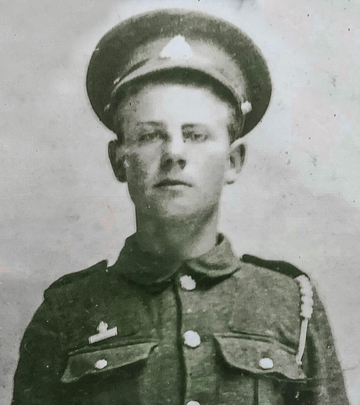Herbert George SMITH
Eyes unknown, Hair unknown, Complexion unknown
Private Herbert George Smith – A British Soldier
This is a story of a British soldier from the 2/1 Bucks Battalion, a counterpoint to the mostly Australian soldiers’ stories on this site and immensely valuable for its origins lying in the first-hand memoirs of a soldier who was present at the Battle of Fromelles. The 2/1 Bucks was a British Battalion fighting alongside the Australian 59th Battalion of the 15th Brigade to “take the Sugarloaf” – the most destructive and lethal German position on the whole of the Fromelles front.
Background
Herbert George Smith was born on 2 March 1897 in Wilby, Suffolk, England, 22 miles north of Ipswich, Suffolk. He was the third of nine children born to parents Elizabeth (nee Baxter) and George William Smith.
Herbert’s father was a horseman and the family moved from farm to farm in the neighbouring villages of Wilby, Brundish, Tannington, Saxtead and Wingfield. Herbert left school in Wingfield at 12 years old, when he had passed the 6th grade standard. In 1911, Herbert was working as a stable hand at Berry's Farm, Wingfield, along with his father.
Home defence
In October 1914, not long after the War started, Herbert just 17 years old enlisted into the British Army.
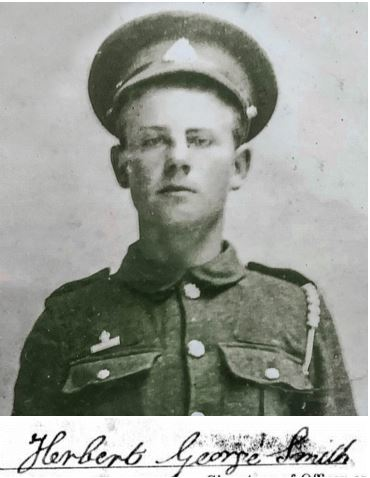
His father, George and his younger brother Stanley also enlisted, leaving Elizabeth at home in Wingfield to raise their remaining seven children by herself. Her youngest child, Albert, was still an infant, born in 1913.
Herbert initially served on the Home Front in the 2/6th (Cyclists Reserve) Battalion, Suffolk Regiment, doing coastal defence, mainly in Suffolk.
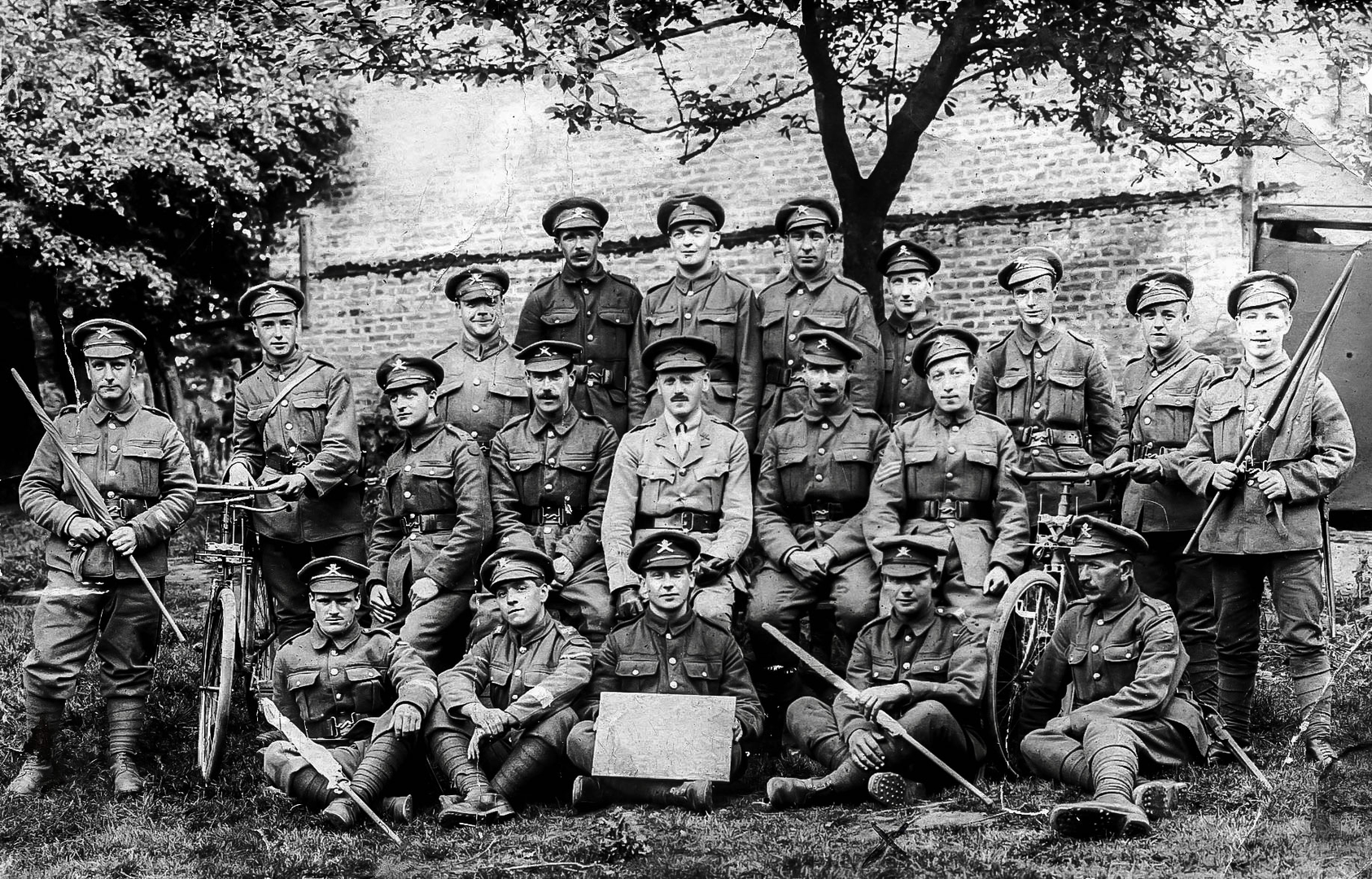
Sweethearts
Just before he went to France, he met Frances May Portus, his future wife, at Pye’s Hall in North Somercotes, Lincolnshire. Herbert was billeted in the barn whilst carrying out patrol duties along the coast while Frances, just fourteen and a half years old at the time, was working as a "day girl" servant in the main house.

Herbert corresponded with Frances throughout the War years, sending her beautiful hand embroidered cards from France, which are now much treasured by his descendants. His father also sent an embroidered postcard to his daughter, Maudie (Alice).
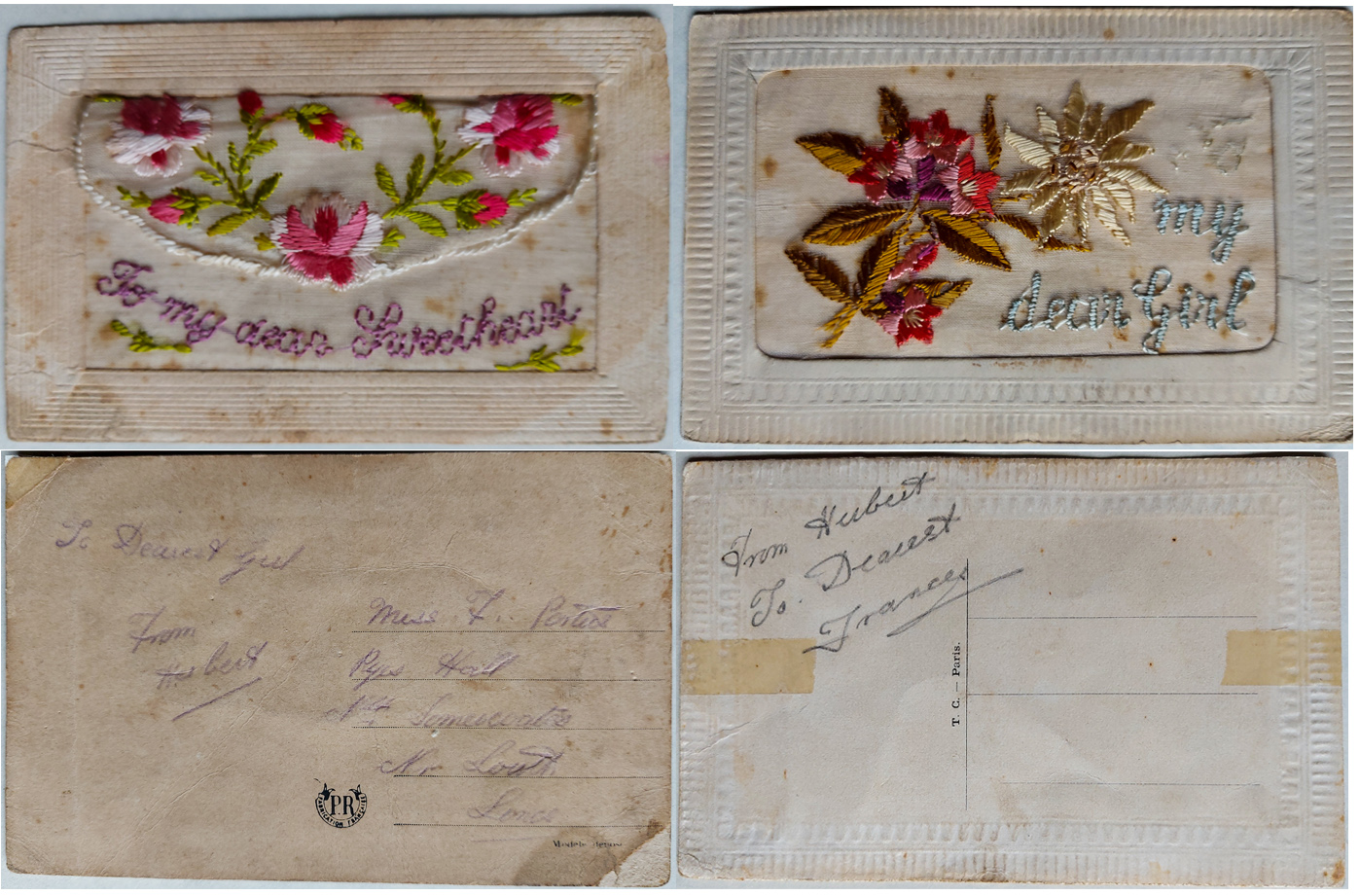
To the Western Front at Fromelles
The following description is based on material from Stephen Berridge’s Second Buckinghamshire Battalion - The Battle of Fromelles 19th July 1916 and the Wolverton and District Archaeological and Historical and Society’ s R. P. Emery’s Memories of World War 1 - Oxford and Bucks Light Infantry 2/1st Bucks Battalion.
On 19 May 1916, Herbert was reassigned to the 2/1 Oxfordshire and Buckinghamshire Light Infantry (2/1 Bucks) Battalion. About a week later, they left Parkhouse Camp for Southampton to embark for Havre and the Western Front.
On arrival in France, the unit entrained for the front, headed for Berguette and then marching to billets at Le Sart, about 20 kilometres from Fleurbaix. They remained there for about ten days before they and the 2/4th Royal Berks were ordered up to Laventie, 2.5 kilometres from the front to take the place of the 2/5th Gloucesters and the 2/4th Oxfords.
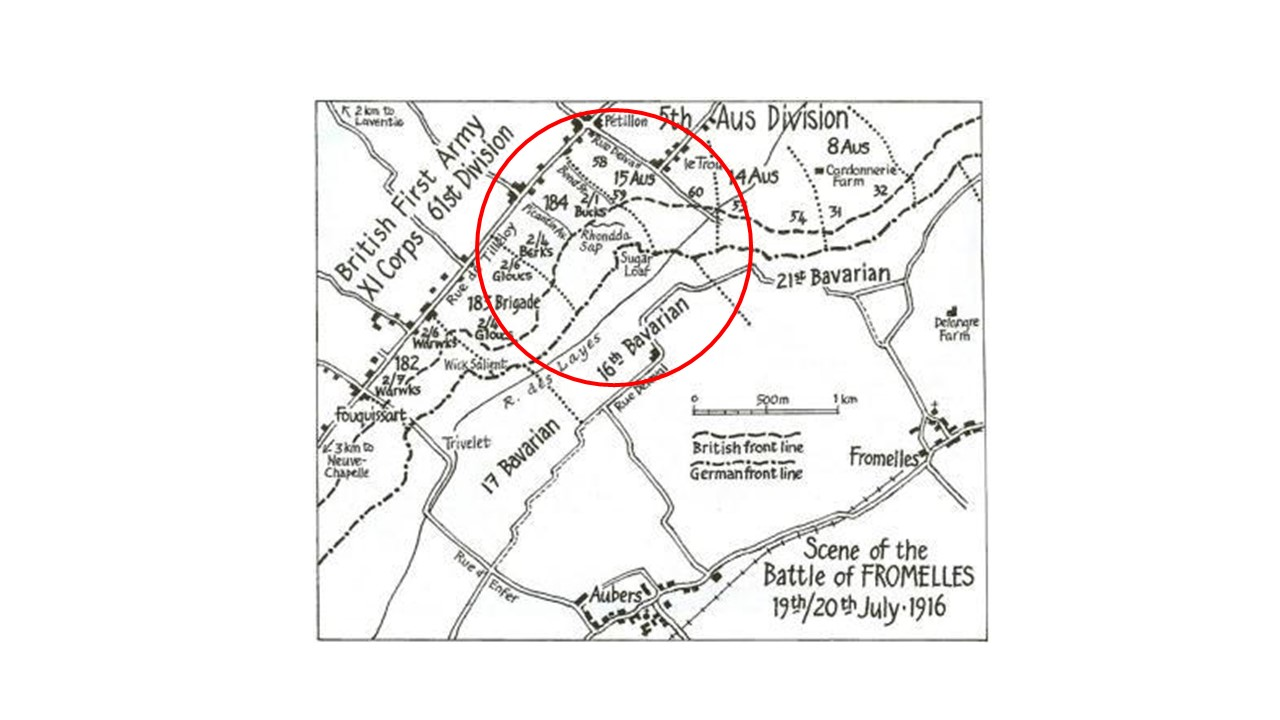
The Division was opposite the Wick and Sugar Loaf salients. Two Battalions from each Brigade were planned for the attack with the remaining two being held in support. The Australians were on the left (facing the German lines) of the Bucks.
The preliminary bombardment for the battle lasted three days. On 18 July “A” Company lost 78 men owing to a shell from one of their own guns falling short, landing on a gas cylinder and bursting it in the trench.
“Zero hour” was set for bombardment to begin at 11am on the 19th. The 2/1 Bucks Battalion strength was 20 Officers and 622 Other Ranks.
The shelling plan had stoppages in the afternoon from four to ten minutes, during which the Infantry in the trenches were to show their bayonets and steel helmets over the parapets, and the officers were to whistle and shout orders. This was hoped to induce the enemy to man their parapet and thereby incur heavy casualties when the Artillery shortened the range onto the front parapet.
However, given the ongoing German shelling and the crowding of the soldiers in the small area of the trenches, by 5.30pm nearly 100 men of the 2/1 had been killed.
At 5.40pm what was left of “A” and “D” Companies filed out into No Man’s Land by Rhondda Sap and they laid down in four rows ready for their attack.
At 6.00pm, with a cheer, the four waves leaped up and assaulted the enemy’s trenches. The leading wave was to get within 80 yards of the enemy’s parapet, if possible, and the next waves were to be spread out by 50 yards each.
The advance was described by an officer of the Royal Flying Corps, observing for the Artillery, as, “Magnificent - not a man was seen to waver, but the fire brought to bear was annihilating. The machine guns literally mowed down the advancing waves. Only a few men actually reached the German parapet. Some were seen actually on the parapet and may have got in, but none got back.”
By 6.30pm, it was evident that the initial attack had failed.
However, it had been asserted that success could have been secured had it been possible to bring two fresh Companies to the assault. No reserves were available, but gradually about 80 men of A, C & D Companies were reorganised and 40 men of B Coy were added. The Commanding Officer of the Battalion was ordered to attack again at 8.30pm.
At 7.30pm the order came to postpone the attack until 9.00pm. At 8.00pm, a further order came through that no attack would take place that night.
Meanwhile, the Australian 59th Battalion had been fighting just to the left of the 2/1 Bucks. However, due to the salient between them communication was limited and the Australians continued with their attacks without the British support from their right.
The 2/1 Bucks had lost 322 men of all ranks. On July 20th, they withdrew to billets near Laventie and on the 22nd to Estaires, 10 kilometres from Fleurbaix.
Herbert’s Memoirs of the Battle
Long after the War, Herbert wrote about the battle in his memoirs which the Smith family preserve and treasure today. The following extracts have some minor edits to assist readability:
"…Our first big engagement was July 19th 1916. We made an attack on Aubers Ridge, a stronghold that the guards brigade had attacked and twice failed. We had little chance for they were better trained men than we were. We were getting up large quantities of stores, ammunition and gas cylinders for a few days, most of it in daylight under full view of the enemy. We were almost advertising it and telling them we were attacking soon. In fact, it was so as it was a sacrificial attack to draw attention and troops from the Somme battleground..."
Herbert went on to write:
"...we put up a barrage for nine hours then made the attack. The Germans bombarded us very heavy - in fact worse than we had given him - and by the time for the attack we had suffered very heavily. Our trenches were blown in and filled with the dead and dying. Most of these were in the front line and few were left for the attack, so the attack depended on those in the reserve trenches who had not suffered so badly but our time was to come...."
"....we were given a lot of rum to give us courage. We were sharpening and fixing our bayonets loading ourselves with ammunition and bombs. Zero hour came....Every man sprang up and over the top into no man’s land.....In battle, we were met by terrible machine gun artillery mortar and bombs. We were mowed down, men falling everywhere..."
And after the battle:
"...Soon we were to go for a rest, all that was left of our battalion…on three old London buses.”
Post Fromelles, Herbert ‘Soldiered On’
Herbert survived Fromelles and went on to serve a further three years in France. On 2 May 1917, he was assigned as a Vickers Machine gunner in the 184th Machine Gun Corps/61st Battalion. He fought in many major battles, including Cambrai, Arras, St Quentin and Pond Farm, sometimes again fighting alongside the Australians.
Herbert wrote of his war experiences after Fromelles as follows:
“After a few weeks we were off again, this time to Arras. Here things went much better for a short time but things began to warm up as we were bombarded by German artillery…....This was a very unfortunate place for me for l was buried by a shell in a little dugout and l had to scramble and work myself out with my hands. Everything around me was like fire and brimstone. In fact, everything looked like fire. It was one big flare. My nerves were shattered and l lost control of myself.....”
His army records show he was wounded 28 August 1917 and his family notes show that he was gassed at some stage.
Of death, injury and capture, Herbert wrote:
"... l was no coward. l had volunteered to serve and l intended to do so....l always had a great fear of being badly wounded - to lay and suffer for an hour or even days as l have seen men who had laid out in no man’s land for about six days.....My other fear was being taken prisoner, for prisoners didn't get off very lightly if they were Machine gunners or bombers like l was... "
Post War
Herbert returned home to England in March 1919 and married Frances on 4 June 1919 in the village Church in Wingfield. They raised two sons, but lost a daughter in 1923 when she was seven months old. Their eldest son, Herbert, and his wife emigrated to Australia in 1956 with ten children, the largest family to do so at that time.
After the war, Herbert initially found work as a clerk with the Royal Navy, but cuts in government spending meant he had to find seasonal work on farms. After some years, he became a foreman at the waterworks, where he worked for twenty-two years.
In later years, still cycling, he was knocked off his bicycle. It was during his recuperation that he wrote his memoirs, with much encouragement from his friends in the Mormon Church. The only battle he described in detail was the Battle of Fromelles.
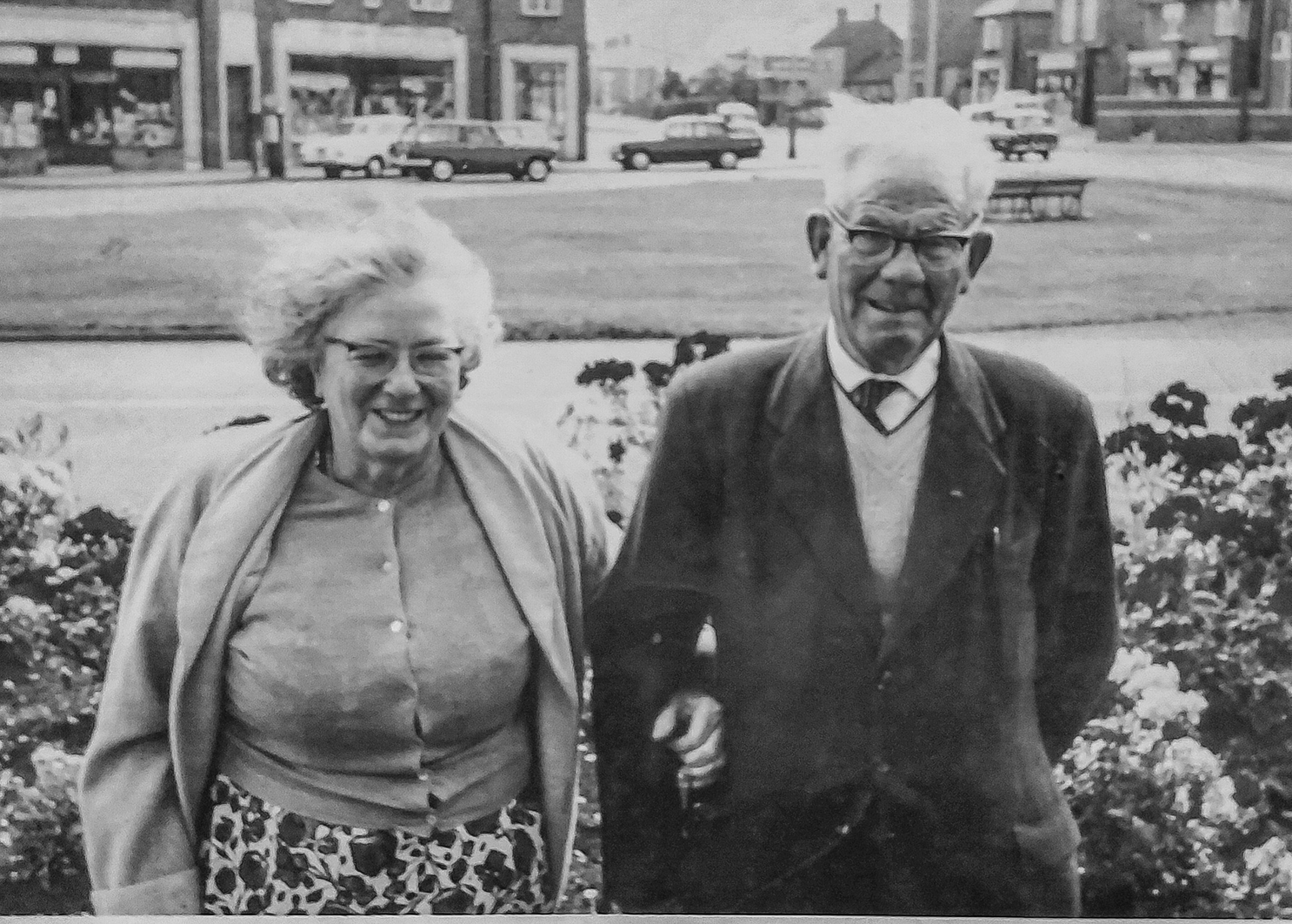
Herbert died in 1969 and Frances in 1995. They are buried in the Loughborough Cemetery, Leicestershire U.K.
The Heavy Price of War
Herbert’s family paid a heavy price in the War as only Herbert survived. Herbert's father, George William Smith, was killed on 19 October 1916 and Herbert’s brother, Stanley, died on 22 July 1917. George is buried in Dartmoor Cemetery on the Somme. They are commemorated in the Churchyard of the Church of St Andrew in Wingfield.
His cousins Percy and Charles Smith from Framlingham also lost their lives, both in 1916. Percy is commemorated on the Theipval Memorial and Charles is buried at Feuchy Chapel, British Cemetery Wancourt, Pas de Calais Plot IV Grave 8.
Apart from his memoirs, Herbert never spoke directly of the war or his experiences.
The Fromelles Association would love to hear from you

Contacts
(Contact: carla@fromelles.info or geoffrey@fromelles.info).
(Contact: army.uwc@defence.gov.au or phone 1800 019 090).
Donations
If you are able, please contribute to the upkeep of this resource.
(Contact: bill@fromelles.info ).
